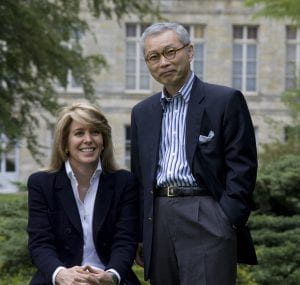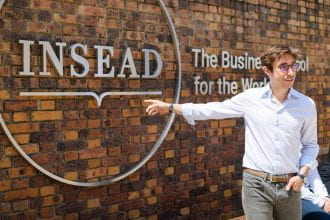INSEAD Alumni Salamander Magazine recently met the Directors of the INSEAD Blue Ocean Strategy Institute Professors W. Chan Kim and Renée Mauborgne for an exclusive interview on their much-anticipated new book Blue Ocean Shift.
INSEAD Alumni: Blue Ocean Strategy is recognised as one of the most iconic and impactful strategy books ever written. Your soon-to-be released new book, Blue Ocean Shift, is already being hailed as one of the biggest books of 2017. What’s the story behind your new book?
Chan Kim and Renée Mauborgne: If Blue Ocean Strategy is the “why”, Blue Ocean Shift is the “how”. Soon after our first book came out, a tidal wave of interest we hadn’t expected grew as companies, governments, nonprofits and even individuals started to look at their world through the lens of red and blue oceans. Suddenly people the world over were identifying themselves as in a red ocean with a call to action to get out and create blue oceans.
This raised the conversation and questions to a whole new level: from “what is blue ocean strategy?” to “how can I shift my organisation from red to blue oceans?”. Established companies were unsure of how to start the process of moving to blue waters, which would often require getting the members of their team to buy into a concept that directly conflicted with the long-established rules of their industries. Entrepreneurs were looking for concrete steps and a systematic process they could follow to create and capture blue oceans at minimal risk.
Hence, what people were keenly interested to understand were the dynamics of actual transformation. What does it take to change, to move an organisation – be it corporate, start-up, government, a nonprofit, even an individual from the red ocean to the blue? Achieving that requires a shift. Not just in strategy. But also in mindset and culture.
To address this challenge head-on we spent the last decade analysing and comparing the successes and failures of blue ocean projects across the globe – that have sprung out of the movement we began – to go beyond competing and to create new frontiers of opportunity, growth and jobs. Analysing a variety of sectors from business-to-customer and business-to-business, to public, nonprofit, and governments – including what worked and what didn’t – we developed a concise understanding of the process of new market creation and growth that unlocks people’s creativity as much as their confidence to act. Blue Ocean Shift is the result.
INSEAD Alumni: What is the gist of Blue Ocean Shift and who is it for?
Chan Kim and Renée Mauborgne: If you want to move from downward pricing pressure to upward pricing possibility, from chasing customers to having customers seek you out, and from competing fiercely and seeing slow growth to inspiring your people’s confidence and seizing new growth, Blue Ocean Shift is right for you.
Whether you are a cash-strapped start-up, nonprofit or a large, established company with bureaucratic obstacles, Blue Ocean Shift will show you how to build your people’s confidence and move from existing markets crowded with competition – or red oceans full of sharks – to wide-open new markets, what we call blue oceans, in a way that brings people along so they own and drive the process.
INSEAD Alumni: Blue Ocean Shift is replete with real-life examples of companies – large and small, nonprofits and even a national government that have applied the tools and approach outlined in your book to move their organisations beyond competing to new value-cost frontiers and wide-open blue oceans. Can you speak of some of them?
Chan Kim and Renée Mauborgne: In line with INSEAD’s commitment to be the business school for the world, we strove to showcase organisations from different corners of the world and across diverse industries, from healthcare to hotels to even prison reform. Readers will learn, for example, how a conductor applied the blue ocean approach to create the first youth orchestra in the Middle East – the National Youth Orchestra of Iraq – that focused on peace and bridging fratricidal divides as much as playing music – both Arab and Kurdish as well as western. The BBC went on to dub it “the bravest orchestra in the world”. Or how Kimberly-Clark Brazil applied the approach to make a blue ocean shift of all things toilet tissue, making over 200 competitors irrelevant and earning strong profitable growth while building its people’s confidence. Or how the French multinational Groupe SEB applied the blue ocean approach and seized explosive growth, turning an industry declining by 10% a year in value to one that grew by 40%. Their blue ocean shift even got Oprah Winfrey tweeting!
What is particularly inspiring about these blue ocean initiatives is that while all opened up new value-cost frontiers, they show how organisations with the same hurdles we all face – be they resource hurdles, politics, or bureaucracy – are able to reach beyond the best, inspire their people’s confidence – (even when at first they are doubtful), and make the shift from red to blue oceans and new growth. By articulating their journeys, including what worked and what didn’t, and how to avoid the potential pitfalls along the way, it is our hope that people will feel the relevance of the ideas to their organisations and appreciate that they too can shift – which they can.
INSEAD Alumni: We are intrigued by two new, big ideas in Blue Ocean Shift. One challenges the popular concept of disruption. The other introduces the beautiful notion of what you call humanness. Can you briefly touch on both and why they matter?
Chan Kim and Renée Mauborgne: In speaking with executives, entrepreneurs, and government leaders, one consistent pattern we’ve observed is how often they associate market creation with the concepts of creative destruction or disruption. Disrupt this, disrupt that. Disrupt or die. That has become a popular mantra. But is disruption the only way to create new markets? And is it the best way? Our research suggests no.
We found that a focus on disruption is limiting and leaves half the opportunities to create new markets and new growth off the table. That other half isn’t about disruption at all. It’s about what we call nondisruptive creation, as new markets are created without disrupting an existing one.
While disruption sets out to offer breakthrough solutions for existing industry problems, nondisruptive creation generates new markets by identifying and solving brand-new problems or seizing brand-new opportunities. Micro-finance, life-coaching, online dating, ringtones, even Viagra are just a few examples of nondisruptive creation.
And as Blue Ocean Shift reveals, the opportunities to unlock nondisruptive creation are huge. For us, that’s not only important, it’s inspiring. As we look to the world around us and the many challenges our planet and human race face in terms of conflicts, new strategic solutions will be needed and if they can be nondisruptive, instead of displacing, we believe there will be a greater chance to create a better world and bring people together instead of divide us apart. That excites us and Blue Ocean Shift shows you how.
INSEAD Alumni: And humanness? We’re intrigued. What do you mean by humanness and what makes it so important?
Chan Kim and Renée Mauborgne: In our study of organisations, we found that the process leading to a successful blue ocean shift must recognise people, acknowledge their fears, their insecurities, their need to be treated with dignity, and their desire to matter. This is what we call humanness. We regard humanness as a key component to making a successful shift, and in fact to any transformational change for it to succeed.
Humanness builds psychological understanding into the blue ocean shift process so that people are willing to engage fully at every step – even when they are hesitant, may not trust one another, or are skeptical of their ability to succeed on the transformation journey. The blue ocean shift process accomplishes this not by demanding that anyone change but by easing people’s fears and building their confidence step-by-step so they own and drive the process and are open to learn and free their imaginations from what is, to imagine what could be. And the good news is, as you will learn in the book, that the three ways our research found to build humanness are reproducible in any organisation.
 W. Chan Kim and Renée Mauborgne are professors of strategy at INSEAD and co-directors of the INSEAD Blue Ocean Strategy Institute. They are the authors of the international bestseller Blue Ocean Strategy and the soon-to-be released follow-up, BLUE OCEAN SHIFT – Beyond Competing: Proven Steps to Inspire Confidence and Seize New Growth, available everywhere from 26 September. If you pre-order your copy here before 26 September, you will receive exclusive bonuses.
W. Chan Kim and Renée Mauborgne are professors of strategy at INSEAD and co-directors of the INSEAD Blue Ocean Strategy Institute. They are the authors of the international bestseller Blue Ocean Strategy and the soon-to-be released follow-up, BLUE OCEAN SHIFT – Beyond Competing: Proven Steps to Inspire Confidence and Seize New Growth, available everywhere from 26 September. If you pre-order your copy here before 26 September, you will receive exclusive bonuses.



